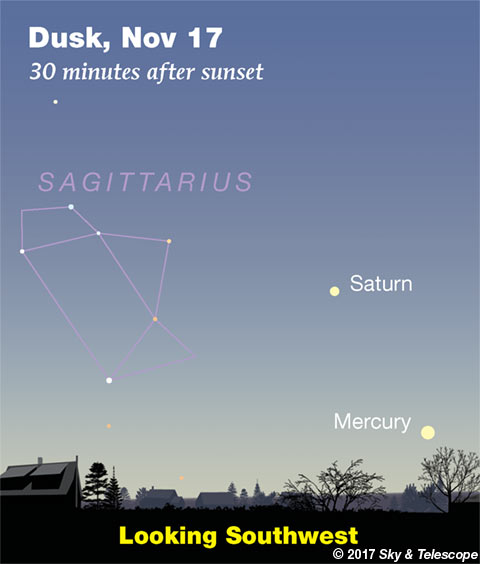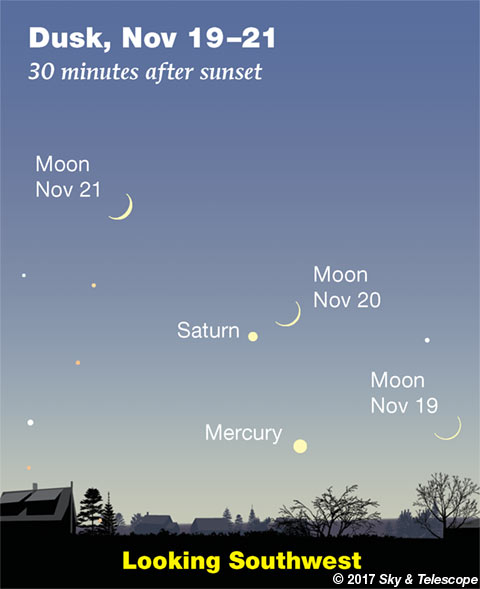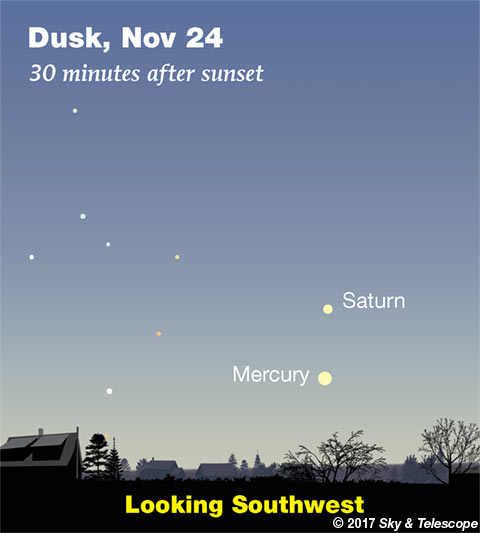


Friday, November 17
• Two challenge planets! As twilight fades, look low in the southwest for Saturn and Mercury, as shown at right. They're about a fist at arm's length apart. Binoculars help.
• With the Moon not yet back in the evening sky, take advantage of the dark nights to explore the galaxies inside the top right corner of the Great Square of Pegasus. A bunch are magnitudes 11 to 13. Use a 6-inch or larger scope and Sue French's Deep-Sky Wonders article, chart and photos in the November Sky & Telescope, page 55.
For a deeper challenge with a large scope, tackle the rich Abell 194 galaxy cluster in Cetus these evenings using Ken Hewitt-White's Going Deep column and photos in the same issue, page 58.
Saturday, November 18
• Around 7 p.m. this week, the Great Square of Pegasus stands in its level position very high toward the south. (It's straight overhead if you're as far south as Miami.) Its right (western) side points very far down toward Fomalhaut. Its eastern side points less directly toward Beta Ceti, not as far down.
Looking lower: If you have a good view to a dark south horizon — and if you're not much farther north than roughly New York, Denver, or Madrid — picture an equilateral triangle with Fomalhaut and Beta Ceti as its top two corners. Near where the third corner would be is Alpha Phoenicis, or Ankaa, in the constellation Phoenix. It's magnitude 2.4, not very bright but the brightest thing in its area. It has a yellow-orange tint; binoculars help to check. Have you ever seen anything of the constellation Phoenix before?
• New Moon (exact at 6:42 a.m. EST).
Sunday, November 19
• A mere 20 or 30 minutes after sunset, scan with binoculars just above the southwest horizon for the crescent Moon and Mercury, as shown in the middle panel here. They're about 8° or 9° apart (for North America). Saturn is to Mercury's upper left.
• Orion is clearing the eastern horizon by 8 p.m. this week (depending on how far east or west you live in your time zone). His three-star belt is nearly vertical. High above Orion shines orange Aldebaran. Above Aldebaran is the little Pleiades cluster, the size of your fingertip at arm's length. Far left of Aldebaran and the Pleiades shines bright Capella.
Monday, November 20
• While twilight is still bright, look low in the southwest for the waxing crescent Moon. Left of it by about 3° (for North America) is Saturn. No more than 20 or 30 minutes after sunset, use binoculars to hunt for Mercury 7° or 8° below them, as shown in the middle panel above.
Tuesday, November 21
• The crescent Moon, now thicker and higher in twilight, points lower right toward Saturn. Mercury again glimmers lower right of Saturn before setting, as shown in the middle panel above.
Wednesday, November 22
• Two faint fuzzies naked-eye: The Andromeda Galaxy (M31) and the Perseus Double Cluster are two of the most famous deep-sky objects. They're both cataloged as 4th magnitude, and in a fairly good sky you can see both with the unaided eye. They're located only 22° apart, very high toward the east early these evenings — to the right of Cassiopeia and closer below Cassiopeia, respectively. But they look rather different, the more so the darker your sky. See for yourself; they're plotted on the all-sky constellation map in the center of the November Sky & Telescope.
Thursday, November 23
• Does the Sun already seem to be setting about as early as it ever will? You're right! We're still a month away from the winter solstice — but the Sun sets its earliest around December 7th if you're near latitude 40° north. And right now it already sets within about 3 minutes of that time.
A surprising result of this: The Sun sets just about as early on Thanksgiving as on Christmas — even though Christmas is much closer to solstice time!
This offset is made up for by the opposite happening at sunrise: the Sun doesn't rise its latest until January 4th. Blame the tilt of Earth's axis and the eccentricity of Earth's orbit.
Friday, November 24
• Whenever Fomalhaut "souths" — crosses the meridian due south, which it does around 7 p.m. this week — the first stars of Orion are just about to rise above the east horizon. And, the Pointers of the Big Dipper stand upright due north, straight below Polaris.
Saturday, November 25
• The bowl of the Little Dipper is descending the northern sky in the evening at this time of year, left or lower left of Polaris. By about 11 p.m. now, it hangs straight down below Polaris.
________________________
Want to become a better astronomer? Learn your way around the constellations! They're the key to locating everything fainter and deeper to hunt with binoculars or a telescope.
This is an outdoor nature hobby. For an easy-to-use constellation guide covering the whole evening sky, use the big monthly map in the center of each issue of Sky & Telescope, the essential guide to astronomy.

Once you get a telescope, to put it to good use you'll need a detailed, large-scale sky atlas (set of charts). The basic standard is the Pocket Sky Atlas (in either the original or Jumbo Edition), which shows stars to magnitude 7.6.
Next up is the larger and deeper Sky Atlas 2000.0, plotting stars to magnitude 8.5; nearly three times as many. The next up, once you know your way around, is the even larger Uranometria 2000.0 (stars to magnitude 9.75). And read how to use sky charts with a telescope.
You'll also want a good deep-sky guidebook, such as Sue French's Deep-Sky Wonders collection (which includes its own charts), Sky Atlas 2000.0 Companion by Strong and Sinnott, or the bigger Night Sky Observer's Guide by Kepple and Sanner.
Can a computerized telescope replace charts? Not for beginners, I don't think, and not on mounts and tripods that are less than top-quality mechanically (meaning heavy and expensive). And as Terence Dickinson and Alan Dyer say in their Backyard Astronomer's Guide, "A full appreciation of the universe cannot come without developing the skills to find things in the sky and understanding how the sky works. This knowledge comes only by spending time under the stars with star maps in hand."
This Week's Planet Roundup
Mercury and Saturn (magnitudes –0.4 and +0.5, respectively) are very low in the sunset afterglow — Mercury especially. Scan for them with binoculars in the southwest, no more than 20 or 30 minutes after sunset if you want a chance of catching Mercury.
Venus, Mars, and Jupiter (magnitudes –3.9, +1.7, and –1.7, respectively) rise before or during dawn in the east-southeast.
First up is Mars, the dimmest. As Mars gains altitude, find Spica below or lower left of it.
Jupiter comes into view well to their lower left as dawn begins.
Venus rises lower left of Jupiter as dawn grows bright. The separation of these two brightest planets is rapidly widening: from 5° on the morning of the 18th to 13° on the 25th. Jupiter is getting higher daily; Venus is sinking ever lower.
Uranus (magnitude 5.7, in Pisces) and Neptune (magnitude 7.9, in Aquarius) are well placed in the southeast and south these evenings. Neptune is 0.6° south of Lambda Aquarii. Use our finder charts online or in the October Sky & Telescope, page 50.
______________________
All descriptions that relate to your horizon — including the words up, down, right, and left — are written for the world's mid-northern latitudes. Descriptions that also depend on longitude (mainly Moon positions) are for North America.
Eastern Standard Time (EST) is Universal Time (UT, UTC, GMT, or Z time) minus 5 hours.
______________________
"The dangers of not thinking clearly are much greater now than ever before. It's not that there's something new in our way of thinking, it's that credulous and confused thinking can be much more lethal in ways it was never before."
— Carl Sagan, 1996
______________________
"Objective reality exists. Facts are often determinable. Vaccines save lives. Carbon dioxide warms the globe. Bacteria evolve to thwart antibiotics, because evolution. Science and reason are not fake news, not a liberal political conspiracy. Civilization's survival depends on our ability, and willingness, to use them."
— Alan MacRobert, your Sky at a Glance editor
______________________
"Facts are stubborn things."
— John Adams, 1770
 1
1








Comments
George Gliba
November 20, 2017 at 11:57 am
Alan,
You forgot about the Leonids, which had ideal Lunar conditions this year. They were good this morning.
I was clouded out for the peak of the Leonids, but on the morning of November 19/20 I was able to get a good hour in with clear LM=6.5 skies from Mathias, West Virginia. From 4:42 to 5:42 EST I was able to see 11 Leonids. The average Leonid was a relatively bright 1.6 magnitude and left a train. I also saw 3 NTA, 3 STA, 1 NOO, 1 AMO, and 9 SPO. There was a beautiful -2, a nice -1, and 2 good 0 magnitude
Leonids seen among them. It was cold, but well worth it.
Screech Owl Hill Observatory - Mathias, West Virginia
You must be logged in to post a comment.
You must be logged in to post a comment.